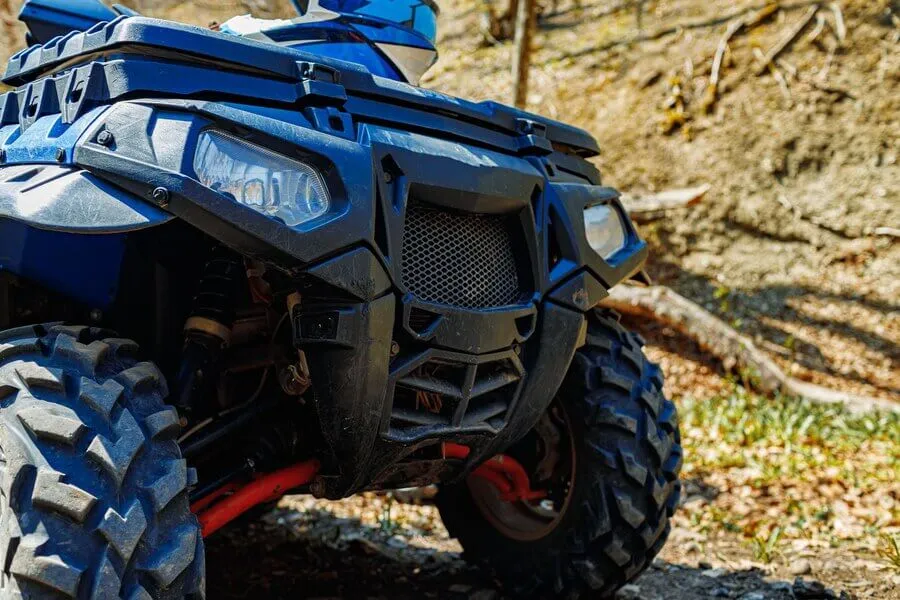Riding and Land Issues

Land Issues
- Travel responsibly on designated roads, trails or areas.
- Travel only in areas open to all-terrain vehicle (ATV) use.
- Minimize wheel spin. On switchbacks, avoid roosting around the apex of the turn when climbing or brake-sliding during descent, both of which gouge the trail. Drive over, not around obstacles to avoid widening the trail.
- Slow down when sight lines are poor. Cross streams only at designated fording points, where the trail crosses the stream.
- Comply with all signs and respect barriers.
- Buddy up with two or three riders, reducing vulnerability if you have an accident or breakdown. Designate meeting areas in case of separation.
- When winching, always inspect your equipment, use the right winch for the situation, find a good secure anchor and never winch with less than five wraps of wire rope around the drum.
- When using a tree as an anchor, use a wide tree strap to avoid damaging the trunk of the tree.
- Listening to headphones or ear buds can make it difficult to hear and communicate with other recreationists. In some areas it is illegal to operate ATVs with both ears covered.
- Don’t mix riding with alcohol or drugs.
- Streams: Cross streams where the trail crosses the stream at a 90 degree angle.
- Cutting switchbacks: Switchbacks are designed to maintain the stability of a trail. Cutting them destroys their integrity.
- Obstacles: Drive over, not around, obstacles such as small rocks and logs to avoid widening the trail.
Respect the Rights of Others
Respect the rights of others, including private property owners, all recreational trail users, campers and others so they can enjoy their recreational activities undisturbed.
- Be considerate of others on the road or trail.
- Leave gates as you find them. If crossing private property, be sure to ask permission from the landowner(s).
- Yield the right of way to those passing you or traveling uphill. Yield to mountain bikers, hikers, and horses.
- Proceed with caution around horses and pack animals. Sudden, unfamiliar activity may spook animals possibly causing injury to animals, handlers, and others on the trail.
- When encountering horses on the trail, move to the side of the trail, stop, turn off your engine, remove your helmet, and speak. You want the horse to know you are human. Ask the rider how to proceed.
- Do not ride around in camping, picnicking, trailhead or residential areas.
- Keep speeds low around crowds and in camping areas.
- Keep the noise and dust down.
Educate Yourself
Educate yourself prior to a trip by obtaining travel maps and regulations from public agencies, planning for your trip, taking recreation skills classes, and knowing how to operate your equipment safely.
- Obtain a map (motor vehicle use map where appropriate) of your destination and determine which areas are open to ATVs.
- Make a realistic plan and stick to it. Always tell someone of your travel plans.
- Contact the land manager for area restrictions, closures, and permit requirements.
- Check the weather forecast before you go. Prepare for the unexpected by packing a small backpack full of emergency items.
- Wear a helmet, eye protection, and other safety gear.
- Know your limitations. Watch your time, your fuel, and your energy.
- Take a class or the ATV Rider CourseSM that provides a fast-paced, half-day, hands-on training session. Call the ATV Enrollment Express toll-free at 1-800-887-2887 to enroll.
- Make sure your ATV is mechanically up to the task. Be prepared with tools, supplies, spares, and a spill kit for trailside repairs.


Avoid Sensitive Areas
- Avoid sensitive areas such as meadows, lakeshores, wetlands and streams. Stay on designated routes.
- Other sensitive areas and habitats to avoid unless on designated routes include cryptobiotic soils of the desert or tundra and seasonal nesting or breeding areas.
- Do not disturb historical, archeological or paleontological sites.
- Avoid “spooking” livestock and wildlife you encounter and keep your distance.
- Motorized and mechanized vehicles are not allowed in designated Wilderness Areas.


